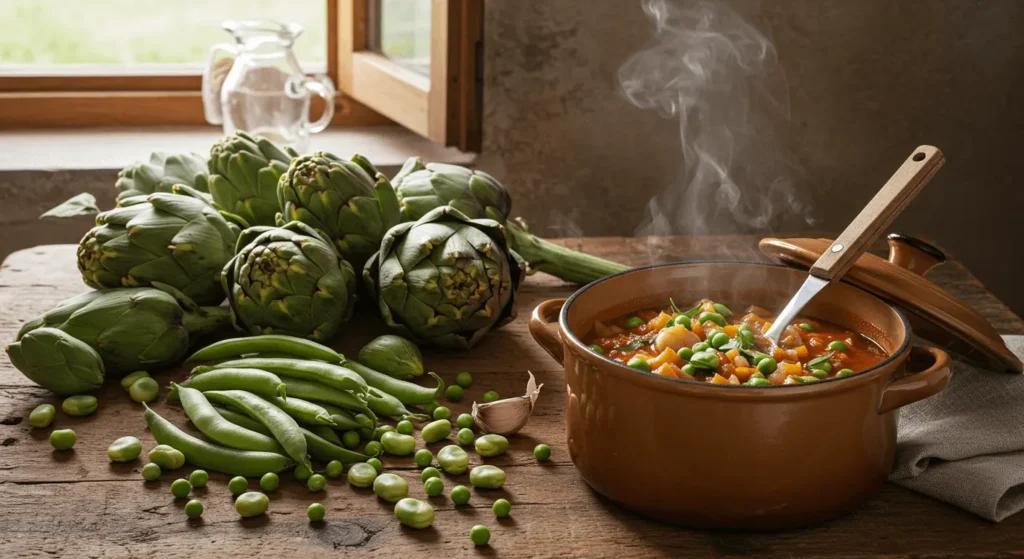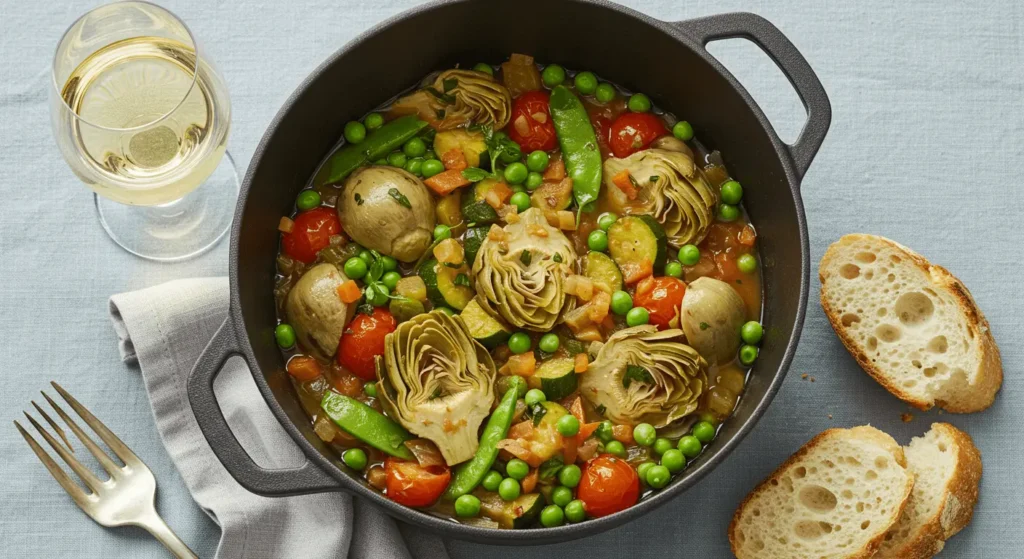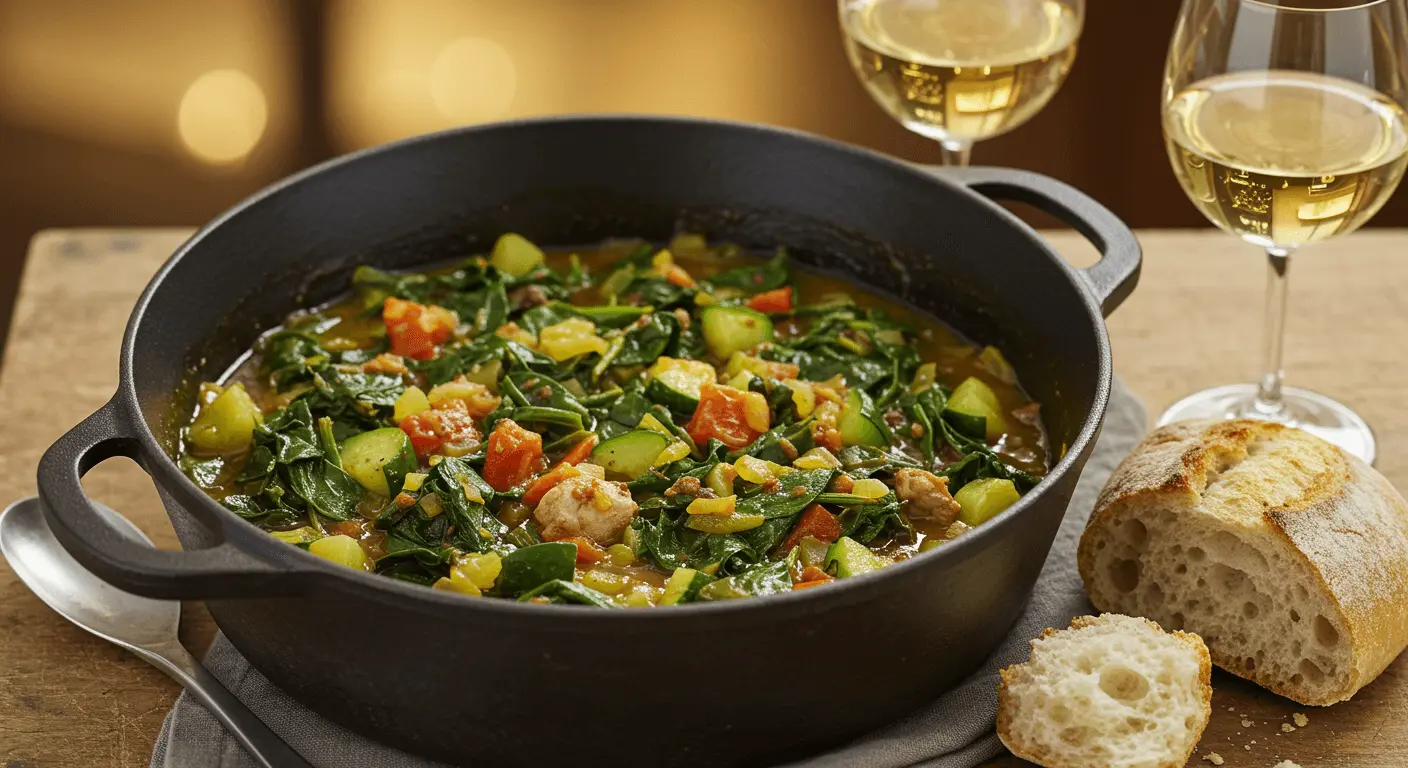As winter fades and spring stretches out its green fingers, the fields of Italy burst into life — and with them comes one of Rome’s most treasured (and underrated) dishes: Vignarola. This humble, heartwarming stew is a celebration of spring vegetables at their peak. Artichokes, fava beans, peas, lettuce — all dancing together in olive oil, garlic, and love. 💚
In this post, we’ll explore everything you need to know about this Roman classic:
- The origins and story behind vignarola 🇮🇹
- The essential ingredients and their springtime symbolism 🌼
- A step-by-step recipe with variations 🧄🥦
- What to serve with it 🍞🍷
- Tips for sourcing ingredients 🌍
- And even how to make a vegan or protein-rich version 🌱
🏛️ The Origins: Vignarola’s Roman Roots
Vignarola comes from the Lazio region, particularly from the countryside around Rome. It’s named after the vignaroli, or vineyard workers, who traditionally grew vegetables between the rows of grapevines. When spring arrived, they would harvest what was ripe — artichokes, broad beans, green peas, spring onions — and cook them together in a pot with olive oil and bits of guanciale or pancetta. 🍇👨🌾
This stew is not just food — it’s terroir, tradition, and timing all in one. It’s one of those rare dishes that only makes sense in spring. Try to eat it in October, and you’ll find it just isn’t the same.
🥬 The Ingredients: A Symphony of Spring
At its heart, vignarola is simplicity done right. But that doesn’t mean it’s boring — quite the opposite. Each ingredient plays a role:
- Artichokes (carciofi): earthy, meaty, and iconic in Roman cuisine 🌱
- Fava beans (broad beans): nutty and buttery; symbolic of spring fertility 🌿
- Green peas: sweet and tender, often the first to ripen in the season 🍃
- Spring onions or leeks: aromatic and delicate 🧅
- Romaine lettuce (yes, lettuce!): adds silkiness and a subtle bitterness 🥬
- Guanciale or pancetta: a traditional Roman touch for umami and fat 🥓 (optional)
- Olive oil, white wine, mint, salt, pepper: minimal seasoning, maximal flavor 🌿🍷
👉 Optional but traditional: a bit of fresh mint or marjoram, for an herbal finish.

🍲 The Recipe: How to Make Vignarola at Home
Let’s dive into the method! This is rustic cooking — nothing fussy, just patience and good ingredients.
✨ Ingredients (Serves 4–6)
- 4 small artichokes, trimmed and sliced thin
- 1 cup fava beans, shelled (about 2 pounds unshelled)
- 1 cup fresh green peas
- 1 large leek or 3 spring onions, sliced
- 1 small romaine lettuce, chopped
- 100g guanciale or pancetta, diced (omit for vegan)
- 1/2 cup dry white wine
- 1/4 cup extra virgin olive oil
- A few fresh mint leaves (or marjoram)
- Salt & pepper to taste
- Optional: squeeze of lemon 🍋
🧑🍳 Step-by-Step Instructions
- Prepare the artichokes
Remove tough outer leaves, trim the tops, and slice thin. Keep them in lemon water so they don’t brown. - Sauté the base
In a large pot, heat olive oil. Add guanciale and let it render until crispy. Then add the leeks or onions and cook until soft. - Layer the vegetables
Add the artichokes first and cook for 5–7 minutes. Then add peas and fava beans. Stir gently, pour in the white wine, and let it evaporate. - Add lettuce and simmer
Toss in chopped romaine, mint, salt, and pepper. Cover the pot and simmer for 10–15 minutes on low heat, until everything is tender but not mushy. - Adjust & serve
Taste and adjust seasoning. Some add a drizzle of lemon juice or more olive oil before serving.
👉 It’s traditionally eaten warm, at room temperature, or even cold!

🥖 What to Serve with Vignarola
- Crusty bread to mop up the juices 🥖
- A glass of Frascati or Vermentino — white wines from Lazio 🍷
- As a side to grilled lamb, roast chicken, or even fish 🐑🐔🐟
- Over pasta, like orecchiette or tagliatelle 🍝
- On bruschetta, topped with Pecorino shavings 🧀
🔁 Variations & Tips
💚 Vegan Version
Just omit the pancetta and increase olive oil slightly. You can also add a splash of vegetable broth for more depth.
💪 Want More Protein?
Add shredded chicken, poached egg, or even white beans.
🌍 No Fresh Favas or Artichokes?
You can use frozen peas or favas. For artichokes, canned hearts (in water, not oil) can work, though they won’t be as tender.
🥣 Leftovers?
Vignarola keeps in the fridge for 2–3 days. It actually tastes better the next day, as the flavors meld!

🧠 Did You Know?
- Vignarola is one of the few Roman dishes that doesn’t rely heavily on cheese or tomatoes.
- The addition of lettuce may sound strange, but it’s very Roman — it softens the stew and adds a grassy bitterness.
- It’s considered a “bridge” dish between winter stews and summer salads — warm, but light.
🌼 Why You Should Make Vignarola This Spring
In a world full of elaborate recipes and long ingredient lists, vignarola is a gentle reminder: eat what’s fresh, cook simply, and savor the season. 🍃
It’s a dish that captures a fleeting moment — when the peas are still tender, the artichokes still plentiful, and the evenings start stretching a little longer.
Make a pot. Invite friends. Tear some bread. Pour wine. Taste spring.
📸 Share Your Vignarola!
If you make this dish, I’d love to see it! Tag me on Instagram with your creations using #SpringVignarola 🌱📷
📝 Final Thoughts
Whether you’re a Roman food purist or a curious cook exploring new seasonal dishes, vignarola deserves a place on your table. It’s a celebration — not just of vegetables, but of seasonality, simplicity, and the joy of good food.
Buon appetito! 🍽️🌿

